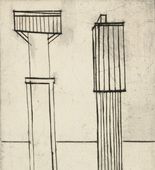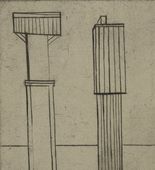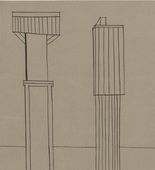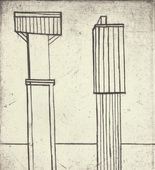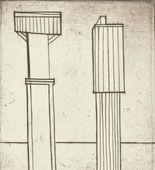
Cat. No. 990.1/V, variant 1
Plate 2 of 9, from the illustrated book, He Disappeared into Complete Silence
- State/Variant:
- Version 1 of 3, state V of VII, variant
- Date:
- 1946-1947
- Alternate Title:
- 2 Abandoned Skyscrapers; Les Maisons Solitaires (The Solitary Houses); Two Figures
- Themes
- Architecture
- Techniques
- Engraving
- Support:
- Smooth, wove paper
- Dimensions:
- plate: 6 13/16 x 5 1/2" (17.3 x 13.9 cm); sheet: 11 1/4 x 7 11/16" (28.6 x 19.5 cm)
- Signature:
- "Bourgeois" lower right margin, pencil.
- Publisher
- unpublished
- Printer
- The artist at Atelier 17
- Edition:
- 5 known impressions of version 1, state V
- Edition Information:
- Proof not included in any known example of “He Disappeared into Complete Silence,” first edition; and proof before the editioning of version 3, state IV, in the second edition. Published examples of the first edition are identified by Example numbers in the Evolving Composition Diagram below. The published example of the second edition is the last entry in the Evolving Composition Diagram.
- Impression:
- Not numbered
- Background:
Bourgeois’s diaries indicate that early in 1947, with the hope of making her work more widely known, she decided to assemble an illustrated book with prints she had made at the Atelier 17 workshop. Her first concept was a seven-print portfolio titled "Les Sept Jours de Ia Semaine" (The Seven Days of the Week). She writes that her ideal publisher would have been Caresse Crosby's Black Sun Press. Remembering that in the 1990s, she laughed and said, "that was a fantasy,'' since Crosby was so well known and Bourgeois was at an early stage of her career.
In her diary, Bourgeois also recounts meetings with poet and literary scholar, Marius Bewley, who wrote the introduction to “He Disappeared into Complete Silence.” They discussed titles of prints and parables to accompany them. Finally, plate numbers were used for the individual prints rather than titles. Two phrases incorporated in the book in lieu of full parables are mentioned in the back-and-forth with Bewley. They are: "The Solitary Death of the Woolworth Building” (accompanying Plate 2) and "Leprosarium Louisiana" (accompanying Plate 6). Titles mentioned but not ultimately used were "Visitors,'' "Maison sans Yeux" (House without Eyes), and "Manhattan Island."
It seems that the book’s overall title, “He Disappeared into Complete Silence,” was first considered as the title for an individual print. Notes also suggest that more than the final nine prints were contemplated; Bourgeois mentions at least twelve additional titles and seven additional brief parables. Some of those titles are "Slow Pulse,'' "The Field Has Been Plowed,'' "Oily Body,'' "X Rays,'' and "Insomnia." In the 1990s, she confirmed that she had originally considered several other compositions for inclusion, remembering, in particular, “L'Allée Montante” (The Uphill Path) (cat. no. 558), “Pont Transbordeur” (Drawbridge) (cat. no. 523), “Le Phare” (The Lighthouse) (cat. no. 644), and “Sacs Ouvert” (Open Sacks) (cat. no. 675). (Related inscriptions appear on these prints.)
In addition to her discussions with poet and scholar, Bewley, Bourgeois sought advice from Alfred H. Barr, Jr., founding director of The Museum of Modern Art, and a friendly acquaintance in this period. In a letter, Barr suggested a revision of the parable accompanying Plate 8, but Bourgeois did not incorporate it. Barr was an early supporter of Bourgeois's work, acquiring an example of “He Disappeared into Complete Silence” for MoMA’s Collection in 1947, as well as a 1950 sculpture “Sleeping Figure,” in 1951. In the illustrated book “The Puritan,” of 1990 (cat. no. 1072-1079), Bourgeois’s text is a 1947 story she had written about Barr, but she does not name him.
It is clear that “He Disappeared into Complete Silence” was an enormous effort for Bourgeois, preoccupying her throughout 1947. There are diary notes about visits to the Print Room of the Brooklyn Museum to study the construction of portfolios; she describes the important features of flaps, covers, and so on, also noting that, "The text should go along with the pictures." She later remembered that with all the organizational aspects of the project, and with the effort needed to finish a relatively large quantity of prints, her final decisions regarding the sequence of plates, and the pairings of images and particular texts, were made in great haste.
In her 1948 diary, there are references to Bourgeois’s attempts, after the project was completed, to bring it to the attention of critics, among them art critic, Clement Greenberg, and literary critic, Philip Rahv, as well as to a broader art public. Some books were left with book dealers George Wittenborn and Harold E. Briggs; others were given away. An off-pink postcard order form exists in two versions: in one, the printed address of Wittenborn is on one side and that of Briggs on the other, along with ordering instructions and pricing at $20. The other version has a separate card for each dealer, with an image of Plate 6 on the verso. Finally, Bourgeois took out ads in “Partisan Review,” vol. 16: No. 3 (March 1949), No. 8 (August 1949), and No. 9 (Sept. 1949). The ad includes a detail of Plate 6 and the information that the volume (limited and signed) was for sale for $20 at Betty Parsons Gallery, 15 E. 57 St, NYC.
The announced edition of the book was not completed in 1947. This frustrated Bourgeois and, much later, in the early 1980s, she began efforts to reissue this work, hoping to complete the edition she had begun so many years earlier. The printing plates no long existed, so she set about producing new ones. She worked first, in 1984, with printer Deli Sacilotto, director of Iris Editions, New York, to create photogravures of 1947 engravings of Plate 1, Plate 3, and the “Alternative Plate.” Then, in 1990, she created engraved versions of Plates 2 and 6 with the assistance of Christian Guérin of Gravure, New York. First, though, in order to determine whether Guérin’s engraving was suitable, she asked him to engrave two similar compositions. (See “Atlantic Avenue: Transparent Houses” [cat. nos. 1054.1, .2, .3].) In 1993, she finally turned the project over to printer Felix Harlan of Harlan & Weaver, New York. He made reprints of some 1984 photogravures and 1990 engravings. In addition, since by then Bourgeois had located three of the original printing plates from the 1940s (two versions of Plate 3 and one version of Plate 4), Harlan made reprints from those, but they were too distressed for use in a future edition. Ultimately, over many years, he coordinated and printed the second edition of “He Disappeared into Complete Silence.” It was finally published in 2005 to benefit the Department of Prints and Illustrated Books, The Museum of Modern Art, New York (cat. no. 1229).- Curatorial Remarks:
- In Wye and Smith, "The Prints of Louise Bourgeois," 1994, p. 78, this impression was catalogued as state III. It has since been determined to be state V.
- Former Cat. No.:
- W & S 30.1
- Description:
- Engraving
- State Changes and Additions:
- Changes from version 1, state IV, in engraving: right structure further developed.
- Artist’s Remarks:
- This scene is "peaceful, even though there is really no point of contact between the two.... The left does not show the total self-confidence that the right does. The right is more perfect. The right is moi, the left is you." (Quote cited in Wye, Deborah and Carol Smith. "The Prints of Louise Bourgeois." New York: The Museum of Modern Art, 1994, p. 78.)
- MoMA Credit Line:
- Gift of the artist
- MoMA Accession Number:
- 387.1993

1946-1947
Plate 2, from the illustrated book, He Disappeared into Complete Silence
1947-2005
Illustrated Book
1947
Illustrated Book
2005
Related Works in the Catalogue
Related Works in Other Mediums


Untitled
c. 1946

Untitled
c. 1946
Medium: Ink and charcoal on tracing paper
Dimensions: sheet: 9 x 7 1/4" (22.9 x 18.4 cm)
© The Easton Foundation/VAGA at ARS, NY


Untitled
1946

Untitled
1946
Medium: Oil on canvas
Dimensions: canvas: 44 × 22" (111.8 × 55.9 cm)
© The Easton Foundation/VAGA at ARS, NY


Femme Maison
1945-1947

Femme Maison
1945-1947
Medium: Oil and ink on linen
Dimensions: canvas: 36 x 14" (91.4 x 35.6 cm)
© The Easton Foundation/VAGA at ARS, NY


Prison & Ladder
1947

Prison & Ladder
1947
Medium: Ink on paper
Dimensions: sheet: 10 5/8 x 10" (27 x 25.4 cm)
© The Easton Foundation/VAGA at ARS, NY


Untitled
1945-1947

Untitled
1945-1947
Medium: Oil and charcoal on canvas
Dimensions: canvas: 36 × 13 3/4" (91.4 × 34.9 cm)
© The Easton Foundation/VAGA at ARS, NY


He Disappeared into Complete Silence
1947

He Disappeared into Complete Silence
1947
Medium: Pencil on paper
Dimensions: sheet: 8 1/2 × 5 1/2" (21.6 × 14 cm)
© The Easton Foundation/VAGA at ARS, NY


He Disappeared Dessin Preparatory
1947

He Disappeared Dessin Preparatory
1947
Medium: Pencil on paper
Dimensions: sheet: 8 1/2 × 3 1/2" (21.6 × 8.9 cm)
© The Easton Foundation/VAGA at ARS, NY


Gemor Press
1947

Gemor Press
1947
Medium: Pencil on paper
Dimensions: sheet: 6 × 3 1/8" (15.2 × 7.9 cm)
© The Easton Foundation/VAGA at ARS, NY


Portrait of Jean-Louis
1947-1949

Portrait of Jean-Louis
1947-1949
Medium: Painted bronze, wall piece
Dimensions: overall: 35 × 5 × 4" (88.9 × 12.7 × 10.2 cm)
© The Easton Foundation/VAGA at ARS, NY


Pillar
1949-1950

Pillar
1949-1950
Medium: Painted bronze and stainless steel
Dimensions: overall: 63 1/4 × 12 × 12" (160.7 × 30.5 × 30.5 cm)
© The Easton Foundation/VAGA at ARS, NY


Memling Dawn
1951

Memling Dawn
1951
Medium: Wood, paint, and stainless steel
Dimensions: overall: 67 1/4 x 15 x 15" (170.8 x 38.1 x 38.1 cm)
© The Easton Foundation/VAGA at ARS, NY


Figure
1954

Figure
1954
Medium: Wood, paint, stainless steel, and nails
Dimensions: 47 1/4 x 12 x 12" (120 x 30.6 x 30.6 cm)
© The Easton Foundation/VAGA at ARS, NY


